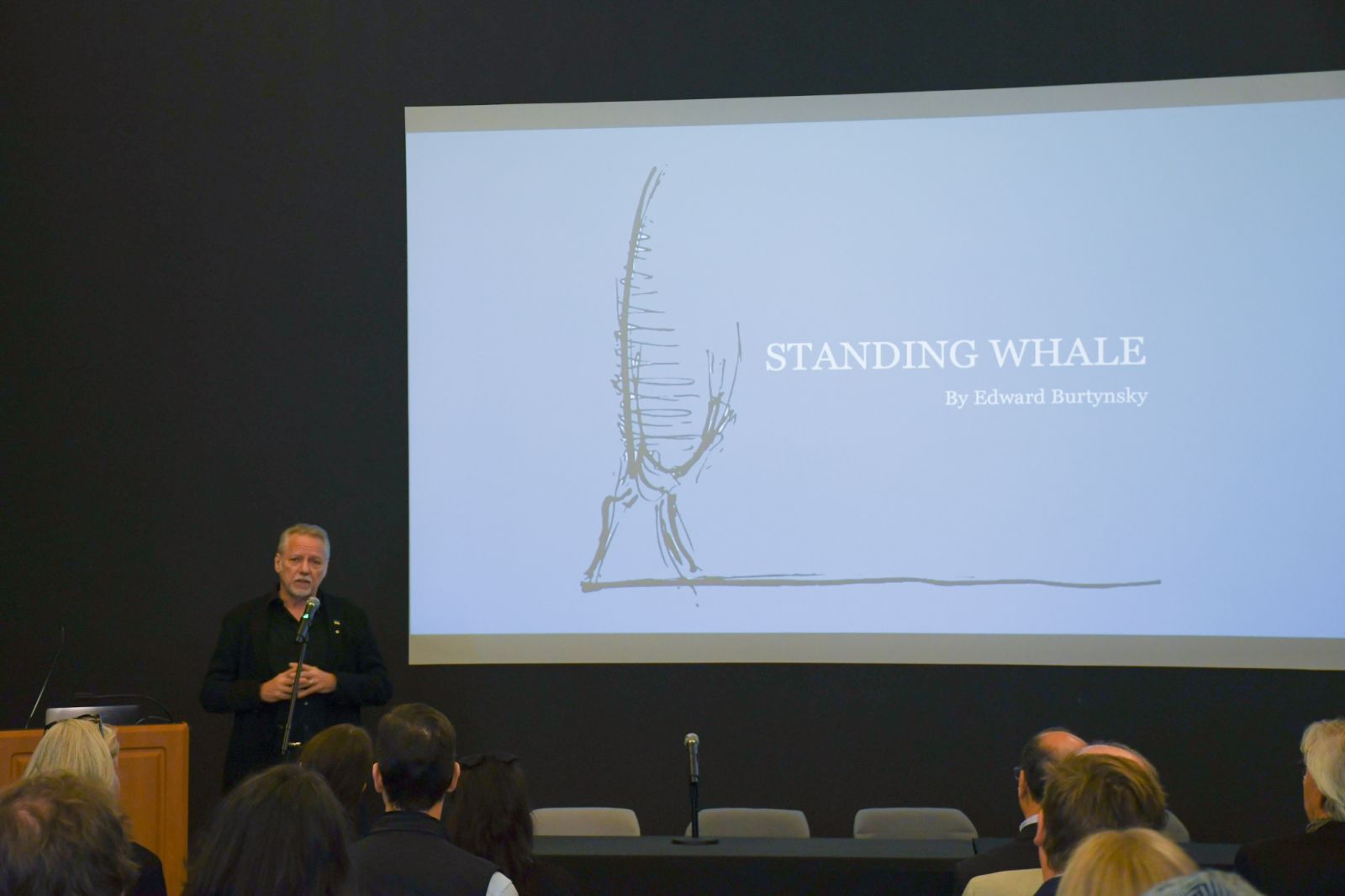Standing Whale might just be a concept in its current form, the vision of world-renowned Canadian artist Edward Burtynsky, but the excitement was palpable at the Agnes Etherington Art Centre last week.
Based on the story of a pod of North Atlantic Blue Whales that perished in an ice event off the coast of Newfoundland in 2014, the proposed public art sculpture is a thematic continuation of Burtynsky’s 40-year artistic practice looking at the impacts of humans on the planet.
Intended to be a true-to-size, 75-foot artistic re-imagining inspired by the retrieved skeletons that washed ashore in 2014, Standing Whale is an acknowledgement to the power of telling our human stories, only this time as a three-dimensional sculpture rather than a two-dimensional image.
During his keynote presentation, Burtynsky talked about the magnificence of the Blue Whale and why it’s critical to help them and, by extension, help our planet.

Edward Burtynsky opens the Standing Whale event.
“These animals are the largest that have ever existed on the planet,” Burtynsky says. “They are three or four times larger than the largest dinosaur and they are still with us. Originally from the hippo family, they adapted from the water to living on land. Despite that, they still have the structure of the front feet of a hippo. This is just a fantastic story to tell.”
Burtynsky says he also wants the whale to stand on its mouth so people can walk in, look straight up at its body from the inside, and marvel at just how small they are compared to the whale that lost its life on our coast just a mere eight years ago.
“It will be a beacon, an antenna, to remind us that they are in our waters. Because they are in the ocean and not on land, we don’t think about protecting them. This will encourage us to ask ourselves how do we affect change in that place, how do we manage that place? It is a complex problem to oversee the health and welfare of these incredible animals. The humanities and sciences need to work together. This is a tough story to tell but it’s great to see them working together on this unique project.”
After the keynote concluded, an expert panel spoke to sustainability issues on our planet and how a project like this is critical to raising awareness. Presented by the Experiential Learning & Programming team in Arts & Science, the panel included Dr. Andy Take (Civil Engineering), Dr. John Smol (Biology), Dr. Kristen Lowitt (School of Environmental Studies), and Dan Hendry (Sustainable Initiatives Consultant). The panel was moderated by Dr. Ryan Danby (Biology).
"We are sleepwalking to disaster," said Dr John Smol, when asked about sustainability and the challenge of timescale perspectives when it comes to the urgency of the climate crisis.

Artist Edward Burtynsky discusses his vision for the Standing Whale art installation.
Faculty of Arts and Science Dean Barbara Crown and Queen’s Engineering Dean Kevin Deluzio spoke to the full house at the Agnes about their enthusiasm around the project.
“I reached out to Kevin and said this was a great opportunity and he was very interested in the idea and working together,” Dean Crow says. “This is yet another fantastic example of how we can work together across the university. I’m excited by the way we have come together with everyone bringing different perspectives to this project.”
During her opening remarks, she revealed her brother has been a fisherman in British Columbia for more than 40 years and has a very intimate relationship with the sea. She fished with him in September and for four hours they were surrounded by whales. “It was spectacular to witness. It was a reminder of how incredible these mammals are.”
Dean Deluzio says at the core of the project for Queen’s Engineering is an incredibly challenging engineering problem that does not have an obvious solution. “This is what we do at this university though, create what hasn’t been created. This artist’s vision of what we are trying to do here speaks to what university is. We are capturing imagination and inspiring the students to be better. We are better when we collaborate across faculties.”
This article appeared in its original form on the Faculty of Arts & Science website.